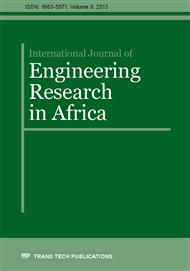[1]
R.M. Cranwell, Ground Vehicle Reliability Design-for-Reliability, DoD Maintenance Symposium, Orlando, Florida, November (2007) 13-16.
Google Scholar
[2]
B.K. Lad, M.S. Kulkani, K.B. Misra, Optimal Reliability Design of a system, Handbook of Performability Engineering, Springer, London, U.K. 2008.
Google Scholar
[3]
T. Jin, D.W. Coit, Approximating Network Reliability Estimates using Linear and Quadratic Unreliability of Minimal Cuts, Reliability Engineering and System Safety, 82, (2003) pp.41-48.
DOI: 10.1016/s0951-8320(03)00117-0
Google Scholar
[4]
J.F. Espiritu, D.W. Coit, U. Prakash, Component Criticality Importance Measures for the Power Industry, Electric Power Systems Research 77, (2007) pp.407-420.
DOI: 10.1016/j.epsr.2006.04.003
Google Scholar
[5]
D.W. Coit, J.R. English, System Reliability Modelling Considering the Dependence of Component Environmental Influences, Proceedings Annual Reliability and Maintainability Symposium, (1999) pp.214-218
DOI: 10.1109/rams.1999.744121
Google Scholar
[6]
W. Kuo, M.J. Zuo, Optimal Reliability Modelling: Principles and Applications, Wiley & Sons Inc., USA. 2003.
Google Scholar
[7]
R. Billinton, R.N. Allan, Reliability Evaluation of Engineering Systems 2nd Ed., Plenum Press USA. 1992.
Google Scholar
[8]
D.W. Coit, T. Jin, Wattanapongsakorn N., System Optimization with Component Reliability Estimation Uncertainty: Multi-Criteria Approach IEEE Transactions on Reliability Vol. 53 No.3 (2004) p.369 – 380.
DOI: 10.1109/tr.2004.833312
Google Scholar
[9]
W. Kuo, R. Prasad, An Annotated Overview of System-Reliability Optimization, IEEE Transactions on Reliability Vol. 49 No. 2 (2000) pp.176-187
DOI: 10.1109/24.877336
Google Scholar
[10]
A. Konak, D.W. Coit, A.E. Smith, Multi-objective Optimization using Genetic Algorithms: A tutorial, Reliability Engineering and System Safety Vol. 91 (2006) pp.992-1007.
DOI: 10.1016/j.ress.2005.11.018
Google Scholar
[11]
H.A. Taboada, D.W. Coit, Data Clustering of Solutions for Multiple Objective System Reliability Optimization problems, Quality Technology and Qualitative Management Journal, Vol. 4 No.2 (2007) pp.35-54
DOI: 10.1080/16843703.2007.11673145
Google Scholar
[12]
D. Salazar, C.M. Rocco, B.J. Galvan, Optimization of constrained multiple-objective reliability problems using evolutionary algorithms, Reliability Engineering And System Safety 91 (2006) pp.1057-1070.
DOI: 10.1016/j.ress.2005.11.040
Google Scholar
[13]
P.S. Shelokar, V.K. Jayaraman, B.D. Kulkarni, Ant Algorithm For Single And Multi-objective Reliability Optimization Problems, Quality and Reliability Engineering International Vol. 18 (2002)pp.497-514.
DOI: 10.1002/qre.499
Google Scholar
[14]
M. Sakawa, Multiobjective Reliability and Redundancy Optimization of a Series-Parallel System by the Surrogate Worth Trade-off Method, Microelectron Reliability Vol. 17 (1978) pp.465-467.
DOI: 10.1016/0026-2714(78)91126-5
Google Scholar
[15]
M. Sakawa, Interactive multiobjective optimization by the sequential proxy optimization technique (SPOT), IEEE Transaction on Reliability, R31 (5) (1982) pp.461-464.
DOI: 10.1109/tr.1982.5221434
Google Scholar
[16]
T. Inagaki, K. Inoue, H. Akashi, Interactive optimization of system reliability under multiple objectives, IEEE Transactions on Reliability R 27 (4) (1978) pp.264-267.
DOI: 10.1109/tr.1978.5220361
Google Scholar
[17]
J. Zhao, Z. Liu, M. Dao, Reliability optimization using multiobjective ant colony systemapproaches, Reliability Engineering and System Safety 92 (2007) pp.109-120.
DOI: 10.1016/j.ress.2005.12.001
Google Scholar
[18]
M.B. Mukuda, Y. Tsujimur, M. Gen, Optimization of Multiobjective System Reliability Design using FLC Controlled GA, Electrical Engineering in Japan Vol. 158 No. 3 (2007) pp.72-80.
DOI: 10.1002/eej.20319
Google Scholar
[19]
D. Coit, A. Konak, Multiple Weighted Objectives Heuristic for the Redundancy Allocation Problem, IEEE Transactions on Reliability, Vol. 55, No. 3 (2006) pp.551-558.
DOI: 10.1109/tr.2006.879654
Google Scholar
[20]
M. Marseguerra, E. Zio, L. Pdofillini, D.W. Coit, Optimal Design of Reliable Network Systems in the Presence of Uncertainty, IEEE Transactions on Reliability Vol 54, No. 2 (2005) pp.243-253.
DOI: 10.1109/tr.2005.847279
Google Scholar
[21]
A.K. Dhingra, Optimal Apportionment of Reliability and Redundancy in Series Systems Under Multiple Objectives, IEEE Transactions on Reliability Vol. 41 (1992) pp.576-582.
DOI: 10.1109/24.249589
Google Scholar
[22]
S.B. Twum, E. Aspinwall, J. Fliege, A Multi-criteria Optimisation Model for Reliability Design of Series-Parallel Systems - Part 1, International Journal of Quality and Reliability Management, Vol. 29 No 8 (2012).
DOI: 10.1108/02656711211272944
Google Scholar
[23]
A. Mettas, ReliaSoft Corporation Tucson, Reliability Allocation and Optimization of Complex Systems, Proceedings, Annual Reliability and Maintainability Symposium, Los Angeles, California, January 24-27 (2000) pp.1-6.
DOI: 10.1109/rams.2000.816310
Google Scholar
[24]
Reliability HotWire, Reliability Allocation and Optimisation, The eMagazine for the Reliability Professional, Issue 6, August 2001. ReliaSoft Corporation USA URL: http://www.weibull.com/hotwire/issue6/hottopics6.htm Accessed: 07/04/(2008)
Google Scholar
[25]
C.F.L. Heimann, Understanding the Challenger Disaster: Organizational Structure and the Design of Reliable Systems, The American Political Science Review, Vol. 87, No. 2 (1993) pp.421-435.
DOI: 10.2307/2939051
Google Scholar
[26]
I.Y. Kim, O.L. de Weck, Adaptive Weighted-Sum Method for Bi-objective Optimization: Pareto Front Generation, Structural and Multidisciplinary Optimization, Vol. 29, (2005) pp.149-158.
DOI: 10.1007/s00158-004-0465-1
Google Scholar
[27]
I. Das, J.E. Dennis, A Closer Look at Drawbacks of Minimising Weighted Sums of Objectives for Pareto Set Generation in Multicriteria Optimization Problems, Structural Optimization Vol. 14, (1997) p.63 – 69.
DOI: 10.1007/bf01197559
Google Scholar
[28]
A.O.C. Elegbede, C. Chu, K.H. Adjallah, F. Yalaoui, Reliability Allocation Through Cost Minimization, IEEE Transactions on Reliability Vol. 52, No. 1 (2003) pp.106-111.
DOI: 10.1109/tr.2002.807242
Google Scholar
[29]
V. Ravi, B.S.N. Murty, P.J. Reddy., Non-equilibrium Simulated Annealing Algorithm Applied to Reliability Optimization of Complex Systems, IEEE Transactions on Reliability, Vol.46 (1997) pp.233-239
DOI: 10.1109/24.589951
Google Scholar
[30]
C.M. Rocco, A.J. Miller, J.A. Moreno, N. Carrasquero, Reliability Optimisation of Complex Systems, Annual Reliability and Maintainability Symposium (2000) Los Angeles, USA.
DOI: 10.1109/rams.2000.816309
Google Scholar


